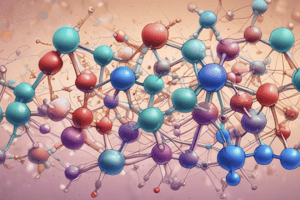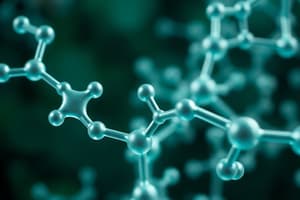Podcast
Questions and Answers
A deficiency in any essential amino acid can prevent growth and may even cause ______.
A deficiency in any essential amino acid can prevent growth and may even cause ______.
death
The bond formed between the carboxyl group of one amino acid and the amino group of another is called a ______ bond.
The bond formed between the carboxyl group of one amino acid and the amino group of another is called a ______ bond.
peptide
Oxytocin and vasopressin are examples of important animal ______ hormones.
Oxytocin and vasopressin are examples of important animal ______ hormones.
peptide
The methyl ester of the dipeptide L-aspartyl-L-phenylalanine is known as ______.
The methyl ester of the dipeptide L-aspartyl-L-phenylalanine is known as ______.
Methionine, Arginine, and Threonine are classified as ______ amino acids.
Methionine, Arginine, and Threonine are classified as ______ amino acids.
The compound formed from the linkage of two amino acids is called a ______.
The compound formed from the linkage of two amino acids is called a ______.
Glutathione is a tripeptide that plays a role in the ______ of toxic compounds.
Glutathione is a tripeptide that plays a role in the ______ of toxic compounds.
A polypeptide consists of many amino acids linked together by ______ bonds.
A polypeptide consists of many amino acids linked together by ______ bonds.
The R groups of amino acids with non-polar aromatic properties include ______, tyrosine, and tryptophan.
The R groups of amino acids with non-polar aromatic properties include ______, tyrosine, and tryptophan.
The property of ______ light absorption at 280 nm is important for protein characterization.
The property of ______ light absorption at 280 nm is important for protein characterization.
The amino acids with polar, uncharged R groups include serine, threonine, ______, methionine, asparagine, and glutamine.
The amino acids with polar, uncharged R groups include serine, threonine, ______, methionine, asparagine, and glutamine.
The two amino acids with acidic R groups are aspartic and ______ acids.
The two amino acids with acidic R groups are aspartic and ______ acids.
Amino acids such as lysine, arginine, and ______ belong to the group with charged R groups.
Amino acids such as lysine, arginine, and ______ belong to the group with charged R groups.
Most amino acids are soluble in ______ but insoluble in non-polar organic solvents.
Most amino acids are soluble in ______ but insoluble in non-polar organic solvents.
Amino acids tend to have high melting points ranging from ______ to 300°C.
Amino acids tend to have high melting points ranging from ______ to 300°C.
Sodium ______ is a valuable flavoring agent used in various dishes.
Sodium ______ is a valuable flavoring agent used in various dishes.
The process of converting light energy into chemical energy in plants is known as ______.
The process of converting light energy into chemical energy in plants is known as ______.
Golden Rice is a genetically engineered variety of rice that has increased levels of ______ to help combat vitamin A deficiency.
Golden Rice is a genetically engineered variety of rice that has increased levels of ______ to help combat vitamin A deficiency.
In crop biotechnology, ______ traits enhance the nutritional value of crops by increasing essential vitamins and minerals.
In crop biotechnology, ______ traits enhance the nutritional value of crops by increasing essential vitamins and minerals.
Techniques like tissue culture and genetic engineering are used in ______ to improve crop yields and resilience.
Techniques like tissue culture and genetic engineering are used in ______ to improve crop yields and resilience.
Nutritional improvement techniques aim to enhance crop quality, particularly in terms of ______ content.
Nutritional improvement techniques aim to enhance crop quality, particularly in terms of ______ content.
The synthesis of carotenoids in plants involves multiple ______ pathways that convert simple compounds into complex molecules.
The synthesis of carotenoids in plants involves multiple ______ pathways that convert simple compounds into complex molecules.
The development of crops with enhanced resistance to pests is an example of improving ______ traits in plants.
The development of crops with enhanced resistance to pests is an example of improving ______ traits in plants.
A significant advantage of Golden Rice is its contribution to ______ improvement in populations that rely on rice as a staple food.
A significant advantage of Golden Rice is its contribution to ______ improvement in populations that rely on rice as a staple food.
The pathway of carotenoid synthesis plays a vital role in the ______ of plants, affecting coloration and health.
The pathway of carotenoid synthesis plays a vital role in the ______ of plants, affecting coloration and health.
Transgenic approaches allow for the insertion of genes that can boost ______ traits in crops, such as drought tolerance.
Transgenic approaches allow for the insertion of genes that can boost ______ traits in crops, such as drought tolerance.
Flashcards
Plant Biochemistry
Plant Biochemistry
Study of the chemical nature of plants and their interactions with the environment.
Carbohydrates
Carbohydrates
Important plant compounds, classified as simple sugars (monosaccharides) and complex sugars (disaccharides and polysaccharides).
Monosaccharides
Monosaccharides
Simple sugars like glucose and fructose.
Disaccharides
Disaccharides
Signup and view all the flashcards
Fatty acids
Fatty acids
Signup and view all the flashcards
Proteins
Proteins
Signup and view all the flashcards
Enzymes
Enzymes
Signup and view all the flashcards
Glycolysis
Glycolysis
Signup and view all the flashcards
Plant Biotechnology
Plant Biotechnology
Signup and view all the flashcards
Callus culture
Callus culture
Signup and view all the flashcards
Essential Amino Acids
Essential Amino Acids
Signup and view all the flashcards
Peptide Bond
Peptide Bond
Signup and view all the flashcards
Dipeptide
Dipeptide
Signup and view all the flashcards
N-terminal amino acid
N-terminal amino acid
Signup and view all the flashcards
C-terminal amino acid
C-terminal amino acid
Signup and view all the flashcards
Glutathione
Glutathione
Signup and view all the flashcards
Peptide Hormones
Peptide Hormones
Signup and view all the flashcards
Aspartame
Aspartame
Signup and view all the flashcards
Imino group of proline
Imino group of proline
Signup and view all the flashcards
Non-polar aromatic amino acids
Non-polar aromatic amino acids
Signup and view all the flashcards
Polar, uncharged amino acids
Polar, uncharged amino acids
Signup and view all the flashcards
Acidic amino acids
Acidic amino acids
Signup and view all the flashcards
Basic amino acids
Basic amino acids
Signup and view all the flashcards
Protein UV absorption
Protein UV absorption
Signup and view all the flashcards
Amino acid solubility
Amino acid solubility
Signup and view all the flashcards
Amino acid physical state
Amino acid physical state
Signup and view all the flashcards
Study Notes
B.Sc. Ag Fundamentals of Plant Biochemistry and Biotechnology I Sem
- Course credit: 3(2+1)
- Syllabus adheres to ICAR 5th Dean Syllabus
- Resources for full BSc Agriculture notes available online (search on Google) at Bscaagriculture.com
111 Fundamentals of Plant Biochemistry and Biotechnology - Theory
- Importance of Biochemistry: Properties of Water, pH, and Buffer (1 lecture)
- Carbohydrates: Importance, classification, structures of monosaccharides, reducing/oxidizing properties, mutarotation, structures of disaccharides and polysaccharides (3 lectures)
- Lipids: Importance, classification, structures and properties of fatty acids (2 lectures)
- Proteins: Importance, classification, structures, titration, and zwitterions of amino acids (structural organization of proteins, enzymes classification, and mechanism of action) (2 lectures)
- Nucleic acids: Importance and classification (structure of nucleotides, A, B, and Z DNA) (1 lecture)
- RNA structure: Types and secondary & tertiary structure (2 lectures)
- Carbohydrate metabolism: Glycolysis, TCA cycle, glyoxylate cycle, and electron transport chain (3 lectures)
- Lipid metabolism: Beta oxidation, biosynthesis of fatty acids (2 lectures)
- Plant Biotechnology Concepts and Applications: (1 lecture)
- In vitro culture techniques: Callus culture, Organ culture, cell suspension culture, embryo culture, anther and pollen culture, ovule culture and their applications (2 lectures)
- Micropropagation methods: Organogenesis and somatic embryogenesis (1 lecture)
- Synthetic seeds and their significance (1 lecture)
- Somatic hybridization and cybrids (1 lecture)
- Crop improvement Somatic hybridization and cybrids, somaclonal variation, cryo-preservation (1 lecture)
- Recombinant DNA methods Physical, Chemical & Agrobacterium-mediated gene transfer methods (2 lectures)
- PCR and its applications (1 lecture)
- Biotechnology regulations (1 lecture)
- Total theory lectures: 44
Studying That Suits You
Use AI to generate personalized quizzes and flashcards to suit your learning preferences.




